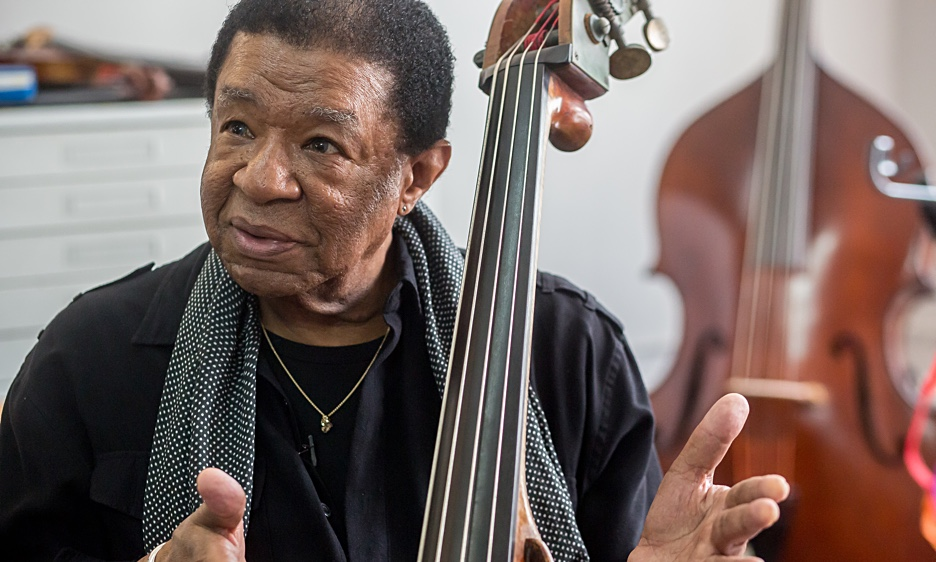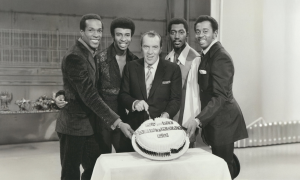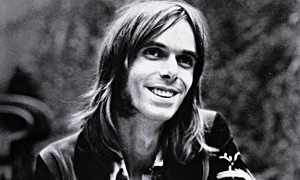Home » Jazz Articles » Film Review » Buster Williams: Bass to Infinity
Buster Williams: Bass to Infinity

 Buster Williams: Bass to Infinity
Buster Williams: Bass to InfinityDirector: Adam Kahan
Distributor or Film Company
USA: 90 minutes
Premier Date: Nov. 12, 2019
This is an exceptional jazz film that most likely would have made its way into art theaters around the world were it not that four months after its premier in New York City, the pandemic struck, and most theaters closed down. However, it is readily available on the web, for example at Amazon Prime, so you don't have to wait for the COVID restrictions to be lifted in order to experience and enjoy it.
Just please make sure if you can that you use a really good sound system, for this is a film built around sound, the sound of the bass violin, otherwise known as the upright or acoustic bass. The film provides as intimate a portrait of the upright acoustic bass as you will ever see or hear it, with closeups of Buster Williams' fingering along the strings, while all the overtones and undertones contribute to the beautiful sound this instrument can make. You can hear the wood vibrating as if to convey infinity, which is one of the several reasons for the film's subtitle: "Bass to Infinity." And Williams' conversations about it illustrate how personal and deep the relationship between instrument and player can get.
There is one thing about this film that may be controversial at least in some circles. The concern does not become apparent until the end of the film, so I will save it for the end of my discussion. Overall, I think it is a uniquely great achievement in documentary film making.
The Incredible Sound of the Bass
Most jazz aficionados think of the bass as part of the rhythm section, and up until the 1950s, what was expected of a bassist was to keep good time and lay down the chord progression with a little bit of filigree along the way. Bill Evans' configuration of the piano trio and the hard bop phase of jazz encouraged bassists to be more lyrical, and Paul Chambers, for example, used the bow to create expressive solos. I was aware of the beauty of the bass sound from such developments, but I came away from this film feeling that I will never hear the bass in quite the same way again.Far from an instrument that you pluck to keep time, like the bathtub bass of the early Dixieland era, the bass violin (I use this term to emphasize that it is part of the string or violin section of the orchestra) has a magnificent sound and infinite ability—in the right hands of course—to create written or improvised lines that are rich and expressive and because of its low register are powerfully moving and supportive of the other instruments. You can hear this power in different guises in the great bassists of the post-bop era, like Chambers, Ron Carter, Scott LaFaro, George Mraz, and Rufus Reid (who appears in the film) to name a few. In fact, the history of the bass in jazz is this very evolution from just beating time to a lyrical improvising "voice." In this film, Buster Williams and the sound engineers deliver a sound that is haunting and intimate.
Playing with the Time Machine
Although centered around Buster Williams and his bass playing, the film is also about an era that is going to be gone soon, the time when the giants of the 1940s to 1960s bebop and hard bop periods are still mingling with the up and coming aspirants and the new leaders of jazz in the New Millennium. The recent passing of jazz greats Jimmy Heath and Chick Corea reminds us how much the glorious musicians who came up in the 1940s-'60s set a standard and became an inspiration for the generations to follow—and how much they will be missed.The vocabulary of jazz expanded vastly then, as it continues to do now, as if a door was opened to "infinity." So when, in one of the opening scenes, we encounter Benny Golson sitting around the Harlem Jazz Museum with Williams, toying on his saxophone with Clifford Brown's tune, "Tiny Capers," and reminiscing about himself and John Coltrane as young Philadelphia musicians naively going up to Manhattan hoping to meet some of the jazz greats, and winding up in Harlem bumping into Thelonious Monk on the street, we know that we, with Williams, are in the territory of the greats being born.
Bringing in Williams' Jazz Master Friends
One of the wonderful features of this film is that the musicians are relaxed, responsive, and in good spirits. None of the self-conscious artificiality that you see in some other documentaries is present here. The extent to which director Adam Kahan and his crew achieved such rapport with the musicians while at the same time providing almost flawless cinematography will become a model for other documentary filmmakers to learn from. The net effect is a film about jazz greats that does justice to and respects them as both musicians and human beings. In this way, the film is a breath of fresh air in this genre and something to delight in.The film next takes us with Williams to a visit with another great bassist, Christian McBride, in the latter's studio at WBGO-FM where he does a highly valued service as announcer and interviewer. Williams grew up in Camden and McBride 30 years later in nearby Philadelphia, and McBride reminisces about Buster's early influence on him when at age 13, he attended a workshop led by Buster, by then a seasoned master. We begin to see what we find emphasized in many other films, books, and studies about jazz, namely the nature of jazz as a collective enterprise where the music crosses generations and musicians are bonding and forming working relationships with one another. Terri Lyne Carrington and Kenny Barron, who appears later in the film, were at that workshop as well.
Williams then goes back to his childhood, his father being a band leader and bassist, and Buster finally settling on the bass as his own instrument. There is obvious love, affection, and parental wisdom in this family, and we see how, as in many other instances of that era, the future jazz musician is exposed to the music on the radio and phonograph from early childhood.
Jammin' with and Gettin' Jammed Up with Gene Ammons and Sonny Stitt
The next scenes show what a great story teller Williams can be. He recounts the almost epic tale of being called as young man to serve as a substitute bassist for Gene Ammons and Sonny Stitt at a club in Chicago. The thrill of a lifetime comes to Williams when, after the set is over, they surprisingly hire him, a fledgling musician, as their bassist for a road trip through the midwest that they are about to take. They are obviously desperate for a substitute bassist. Little does Williams know what is about to ensue. On one gig, Ammons disappears: it turns out he has gone to Chicago to get some drugs to feed his addiction. Williams is faced with the reality of the seamy side of the jazz life, but thankfully, having been raised in a loving and wholesome God-fearing family, he avoids the addictions and compromise of values that haunted jazz at the time.For some reason, Kahan uses animated cartoons rather than still photos or film footage to visualize parts of Williams' story. Opinions will be mixed about this approach. I personally was initially put off by it, but on subsequent views I became more comfortable with this media mix. The story itself is one of the strongest, heartfelt descriptions of how addictions sabotaged the lives and work of otherwise brilliant and gifted individuals. Animation imagery does not seem to fit with the seriousness of the message, but it works, perhaps, as a way to provide some emotional distance from these musicians' very stressful and often tragic lives. The real point the film is trying to make is how some musicians like Williams avoided the traps.
In the midst of some further reminiscences, we are called back to the present when Williams and another great bassist from the same generation, Rufus Reid, talk about the magic of the bass as an instrument. The whole idea of these sequences seems to be about how the bassist's relationship with his instrument is so intimate, that it has a personality and will of its own. Thus, Williams relates how, when a musician other than himself used his bass, it seemed to protest by losing its resonance until Williams picked it up again. What Rufus and Buster have in common is their ability to use this instrument to raise the group to a high level of a performance. Williams himself points out in the film that the bassist's responsibility is to facilitate a cohesive performance where all the musicians are in synch rhythmically and otherwise with one another.
Workin' with Sarah Vaughan, Nancy Wilson, and other Vocalists
A central point of From Bass to Infinity is about the practical choice that Williams made during part of his career to go tour with women singers rather than with some of the great instrumentalists he could have worked with. The reason was simple: their gigs were more dependable and paid more money! Nancy Wilson paid him a retainer (payment in advance) which is very unusual and assured him a steady income, and she bought him a bass he wanted. But in addition to that, as the film repeatedly makes clear, singers have a lot to teach instrumentalists about sound, lyrics, and a host of other things that are very important to the jazz idiom. Williams went on tour with Sarah Vaughan and then for a more extended time period with Wilson. In the film, he has an extended dialogue and duet music making with the vocalist Carmen Lundy at the most recent incarnation of Birdland. This scene to me is the most touching in the film and leaves the most lasting impression. The personal enjoyment, respect, and rapport they have for one another shines through, and some of their exchanges could serve as workshop material for vocalists and instrumentalists working together.Musicians at Play
Staying in the present moment now, we next see Williams in a trio rehearsal with Kenny Barron and drummer Lenny White. They are taking a break before rehearsing Monk's "We See," and Williams relates how he once had a dream that told him to call White for a gig at Sweet Basil, which led to their hooking up again. This is one among several examples which reveal Williams' belief in the ability of mind to change reality. But there is also a lot of banter and humor between the three men. The film illustrates how musicians reunite for a gig, and in this case humor is a way of re-establishing the connection.Nam Myoho Renge Kyo
The film began with the ringing sound of a Buddhist cupped chime, another suggestion of "infinity," but little is said about it until the later scenes in the film, beginning with Herbie Hancock, who introduces himself in a very Zen way, and then relates how, when they were both young, Williams was playing a gig with him and did a solo that knocked everyone out, as if it had a transformational effect on the players and the audience. Footage from this gig are played. At the time, Hancock asked Williams how that playing came about, and Williams says he had been practicing Nichiren Buddhism with its powerful chant, "Nam Myoho Renge Kyo." We hear Williams chanting, and we begin to see that he considers the music as an expression of the power of the chant along with his Buddhist studies. This connection between the musical and the spiritual appears frequently in the history of jazz. Hancock, Wayne Shorter, and a personal friend of mine, saxophonist/composer Bobby Zankel, all practice Nichiren Buddhism. John Coltrane was a spiritual seeker, immersing himself in several of the world religions. Sonny Rollins has been practicing yoga and meditation for decades. The list goes on and on. Williams is telling us how everything in his life is part of his spiritual practice.The Race Card
Finally, the great and under-recognized pianist Larry Willis is conversing with Williams and brings up the importance of African-American culture in jazz. The film seems to have been arranged to leave it to the viewer how important race, ethnicity, and culture is in this story. There is no question that race relations—positive and negative—have played a major role in the development of jazz music as well as the jazz business in all its many aspects. The questions are what role has race relations played in Buster Williams' life, and what role does it play in the film?Although it is never mentioned in the movie, we cannot doubt that an African American like Williams coming up in Camden, NJ in the 1940s-50s experienced some bullying and discrimination. Aspiring to be a jazz musician, Williams being black probably brought him favor among other black musicians. Conversely, it almost certainly meant that he would be manipulated by record company executives, although he had a very savvy business sense. So why are these issues of race and ethnicity, which emerge in almost every biography of a black jazz musician, never raised in the movie? The only thing I could find that might explain it is an almost shocking statement by the director Adam Kahan in an interview about his film on Rahsaan Roland Kirk, the blind saxophonist who could play several instruments simultaneously. Kahan is talking about the hopes for jazz in the future:
"I think in order for what we know as Jazz to progress, we have to kill it. It's like the race problems we have in this world. They are not going to disappear until we get rid of all the white people. And black people. And all the others. And everyone just screws each other until the color line is forever blurred."**
In a histrionic way, Kahan is saying that differences such as color, race, religion, ethnicity, etc. inevitably polarize groups, and jazz has suffered from that polarization. Of course that is only partly true. The opposite is also true. White, black, brown, yellow, red jazz musicians from all over the world have learned from their cultural and musical diversity to create new forms, new genres, new ways of playing that have increased the power of jazz since its inception. The future of jazz depends on diversity. But Kahan seems, intentionally or not, to have minimized it in this film, until the very end, where it is raised as an issue.
Another aspect of this film that I was unaware of until I watched it through a second time is that all or nearly all the cast in this film are African American! In other words Kahan reversed the usual discrimination against black actors in Hollywood movies. Does this mean that all the significant figures in Williams' life are black? Does it mean that the director was trying to make a point? All I can say is that I did not feel any "reverse discrimination" in the film. But Williams did many gigs with white musicians, including Stan Getz and Chet Baker. Were none of them close friends with him?
I suspect, without any evidence to prove it, but based on reportorial instinct, that Kahan used the race card to make a point. What that point is, I don't know. But the beauty of this film is that it tells a story in a symbolic, allegorical way which is rarely found in a documentary. Everything in this film has symbolic significance, which is what draws the viewer more and more deeply into it. Thus Spake Zarathustra! Like the protagonist in Nietzsche's novel, Buster Williams strives for transcendence. There are many mountains to climb in that quest. One of them will be the next time he solos on a gig.
References
- * Herbie Hancock, Daisaku Ikeda, and Wayne Shorter. Reaching Beyond: Improvisations on Jazz, Buddhism, and a Joyful Life. Santa Monica Press, 2017.
- ** Quoted from interview: Meet the Filmmaker: Adam Kahan (The Case of the Three-Sided Dream)
Tags
Film Review
Buster Williams
Victor L. Schermer
Paul Chambers
Ron Carter
Scott Lofaro
George Mraz
Chick Corea
benny golson
John Coltrane
Thelonious Monk
Christian McBride
Terri Lyne Carrington
Kenny Barron
Gene Ammons
Sonny Stitt
Rufus Reid
Nancy Wilson
Sarah Vaughan
Carmen Lundy
Lenny White
Herbie Hancock
Wayne Shorter
Bobby Zankel
Sonny Rollins
Larry Willis
Rahsaan Roland Kirk
PREVIOUS / NEXT
Buster Williams Concerts
Jan
23
Fri
Stream
Jan
24
Sat
Stream
Support All About Jazz
 All About Jazz has been a pillar of jazz since 1995, championing it as an art form and, more importantly, supporting the musicians who make it. Our enduring commitment has made "AAJ" one of the most culturally important websites of its kind, read by hundreds of thousands of fans, musicians and industry figures every month.
All About Jazz has been a pillar of jazz since 1995, championing it as an art form and, more importantly, supporting the musicians who make it. Our enduring commitment has made "AAJ" one of the most culturally important websites of its kind, read by hundreds of thousands of fans, musicians and industry figures every month.























